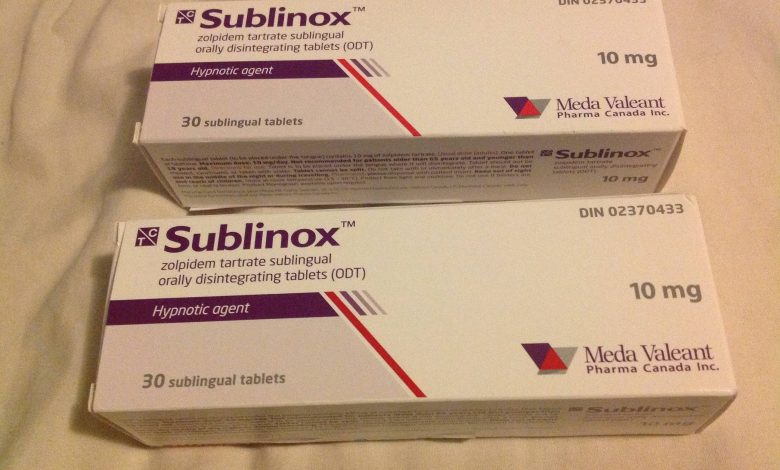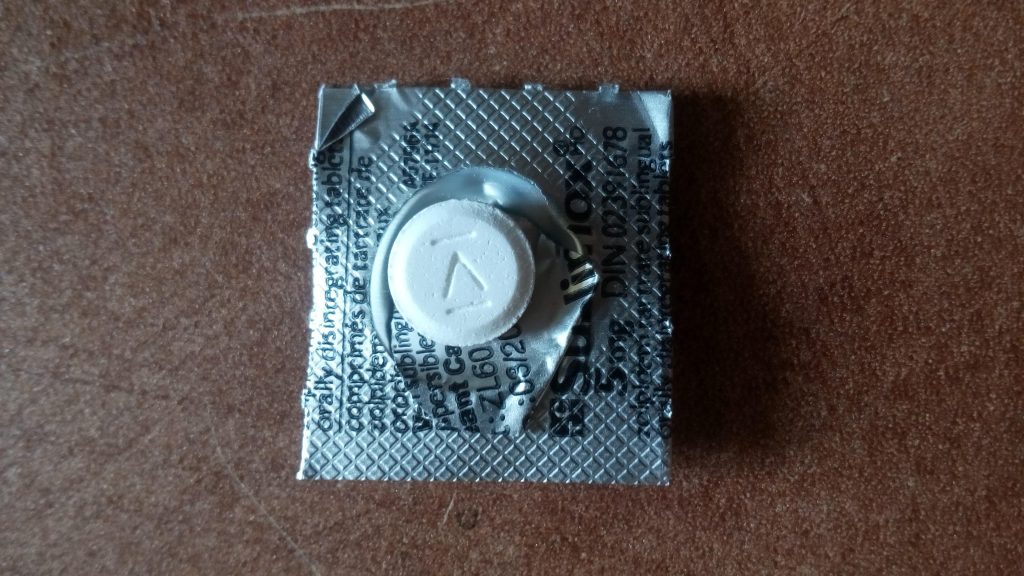Sublinox 10 & 5mg: How it works, Uses, Dosage, Side Effects, Reviews

What is Sublinox?
Sublinox is a Canadian brand of sublingual orally disintegrating tablet formulation of zolpidem, a non-benzodiazepine hypnotic used in the short-term treatment of insomnia.
Sublinox was developed to provide a more rapid onset of action than oral immediate-release zolpidem. Sublingual zolpidem has demonstrated bioequivalence to oral zolpidem. Sublinox comes in 2 forms namely:
- Sublinox 5 mg: A round, white, flat-faced, beveled-edged, sublingual tablet, marked with “V” on one side, contains 5 mg of zolpidem.
- Sublinox 10mg: A round, white, flat-faced, beveled-edged, sublingual tablet, marked with “X” on one side, contains 10 mg of zolpidem.
*Sublinox does not come in 20mg sublingual orally disintegrating tablet formulation.

How does Sublinox work?
Sublinox contains zolpidem which belongs to a class of drugs called hypnotics. A class of drugs is a group of medications that work in a similar way. These drugs are often used to treat similar conditions.
Sublinox works by increasing the activity of GABA. GABA is a chemical in your body that causes sleepiness. Increasing its activity helps you fall asleep.
How long does it take for Sublinox to work?
The peak effect of Sublinox usually happens about 90 minutes after taking it, but you may start to notice its effects as early as 15 to 30 minutes. If you take Sublinox with food, the effects tend to happen more slowly.
How to take Sublinox
The Sublinox dosage your doctor prescribes will depend on several factors. These include:
• the type of insomnia you’re using Sublinox to treat
• your age or sex
• the form of zolpidem you take
• other medical conditions you may have, such as liver damage
Typically, your doctor will start you on a low dosage and adjust it overtime to reach the dosage that’s right for you. They’ll ultimately prescribe the smallest dosage that provides the desired effect.
The following information describes dosages that are commonly used or recommended. However, be sure to take the dosage your doctor prescribes for you. Your doctor will determine the best dosage to suit your needs.
Dosage for insomnia with trouble falling asleep
Adult dosage (ages 18–64 years)
• Starting dosage: Sublinox 5 mg for women and 5 mg or 10 mg for men, taken right before bedtime. You should only take a dose if you have at least 7–8 hours before you need to wake up.
• Dosage increases: Your doctor may increase your dosage to 10 mg per day if the Sublinox 5 mg dose is not effective.
• Maximum dosage: 10 mg once per day taken right before bedtime.
Child dosage (ages 0–17 years)
This medication hasn’t been studied in children. It shouldn’t be used in people younger than 18 years.
Senior dosage (ages 65 years and older)
The liver of an older adult may not work as well as it used to. This can cause your body to process drugs more slowly. As a result, more of a drug stays in your body for a longer time. This raises your risk for side effects. Your doctor may start you on a lowered dosage or a different treatment schedule. This can help keep levels of this drug from building up too much in your body.
• Sublinox 5 mg once per day taken right before bedtime.
Special dosage considerations for people with liver disease
• Sublinox 5 mg once per day taken right before bedtime for people with mild to moderate liver disease. Avoid this drug if you have severe liver disease.
Sublinox will work faster if it is not taken with a meal or immediately after a meal. Follow the directions on your prescription label carefully, and ask your doctor or pharmacist to explain any part you do not understand. Use Sublinox exactly as directed.
Is Sublinox addictive?
Yes, Sublinox is addictive, in fact, it is now recognized that Sublinox has a similar abuse potential to Benzos. Data from the Substance Abuse and Mental Health Services Administration (SAMHSA) indicates that in 2017, approximately 9.5 million individuals reported using zolpidem products in the past year, and about 900,000 were estimated to have misused the drug.
However, while it generally takes users longer to develop an addiction to Sublinox than to Benzos and withdrawal from Sublinox is generally less severe and dangerous than Benzo withdrawal. It’s best to only take Sublinox for short periods of time, to lower the risk of becoming dependent on the medication.
How long does Sublinox stay in your system?
Sublinox works relatively quickly, and it remains in the body for a short period of time. It has a rapid onset of action within 30 minutes, with peak effects reached within 1–2.5 hours for most people, depending on whether the person took an immediate- or extended-release version of the drug.
With higher doses, it can be detected for up to 72 hours in urine and up to 48 hours in blood.
The drug has a relatively short elimination half-life of about 2 hours. The half-life of a drug refers to the amount of time it takes an individual’s system to eliminate half of the dose. However, elderly patients and those with liver impairment may take longer to metabolize the drug and may require reduced dosing to avoid toxicity.
Because Sublinox is metabolized relatively quickly, it is typically only detectable in urine for 24-48 hours in most individuals taking therapeutic doses. Blood tests may detect it for 6-20 hours. With higher doses, it can be detected for up to 72 hours in urine and up to 48 hours in blood. Though Sublinox is relatively poorly absorbed into growing hair, one study detected it in hair up to 5 weeks after taking the drug.
The above-stated detectability times are general ranges. However, there is bound to be some variation in how people metabolize different substances, which may influence their detectability. The detectability window of Sublinox may be affected by numerous variables, including:
• Age.
• Gender.
• Weight.
• Liver and kidney function.
• Metabolism.
What are the side effects of Sublinox?
Sublinox may cause side effects. Tell your doctor if any of these symptoms are severe or do not go away:
• changes in appetite
• constipation
• diarrhea
• difficulty keeping balance
• dizziness
• drowsiness
• ‘drugged feeling’
• dry mouth or throat
• eye redness
• gas
• headache
• heartburn
• heavy menstrual bleeding
• joint, back, or neck pain
• lightheadedness
• muscle aches or cramps
• nausea
• pain, burning, numbness, or tingling in the hands, arms, feet, or legs
• redness, burning, or tingling of the tongue (with sublingual tablets)
• ringing, pain, or itching in the ears
• stomach pain or tenderness
• tiredness
• uncontrollable shaking of a part of the body
• unsteady walking
• unusual dreams
Some side effects can be serious. If you experience any of the following symptoms, call your doctor immediately:
• blurred vision or other vision problems
• chest pain
• difficulty breathing or swallowing
• feeling that the throat is closing
• hives
• hoarseness
• itching
• light-colored stools
• nausea
• pounding heartbeat
• rash
• shortness of breath
• swelling of the eyes, face, lips, tongue, or throat
• vomiting
• yellow eyes or skin
Sublinox may cause other side effects. Call your doctor if you have any unusual problems while you are taking this medication.
If you experience a serious side effect, you or your doctor may send a report to the Food and Drug Administration’s (FDA) MedWatch Adverse Event Reporting program online (http://www.fda.gov/Safety/MedWatch) or by phone (1-800-332-1088).
Sublinox drug interactions
Sublinox can interact with other medications and substances that cause drowsiness. These interactions carry a higher risk of a serious reaction, such as altered thinking, behavior problems, and too much sedation.
Many people who experience severe health problems from Sublinox are combining it with other medications. Mixing Sublinox with opioid pain relievers, anti-anxiety medications, muscle relaxers, or alcohol can be dangerous.
Always talk to your healthcare provider and pharmacist about other medications you are taking if you are prescribed Sublinox.
Sublinox precautions
If you are prescribed Sublinox, there are a few precautions to be aware of:
- You should avoid driving or operating machinery after Sublinox, until it begins to wear off. This is generally about 8 hours after you’ve taken a tablet.
- If you are 65 or older, you should also use extra care when walking around the house after taking Sublinox, because of the risk of falling. It’s best to take a tablet right before you plan to get in bed.
- If you stop taking Sublinox abruptly, after taking it daily for longer periods of time, you can experience withdrawal effects, such as insomnia or vomiting. Always talk to a healthcare provider if you plan to stop taking Sublinox.
What to avoid when taking Sublinox
Since Sublinox causes sleepiness and sedation, you should avoid taking it with over-the-counter (OTC) sleep aids. Combining them could cause dangerous levels of drowsiness. You should also avoid using recreational drugs when taking Sublinox due to the risk of serious side effects.
Sublinox should only be taken if you have at least 7 to 8 hours to devote to sleep. Avoid trying to wake up before that amount of time has elapsed. Doing so could raise your risk of accidental injuries.





